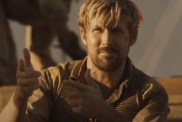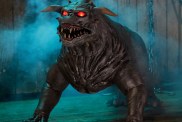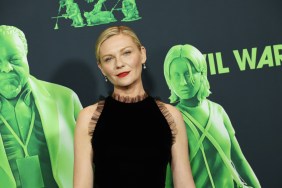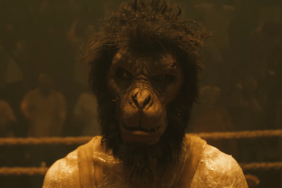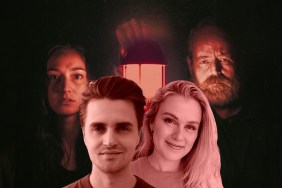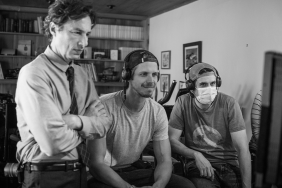Quick, who directed the original The Wolf Man in 1941? Don’t worry, I don’t expect you to come back with George Waggner (at least not right away), but I’m sure had I asked who starred as Lawrence Talbot (a.k.a The Wolf Man) you would have easily come up with Lon Chaney Jr. The original, and now classic, monster movie is fondly remembered by many and is still remarkably entertaining, primarily because it never takes itself too seriously and instead of dedicating itself to man-to-wolfman transformations it sets out to tell a story first — something the recently released The Wolfman from Universal never does.
Universal’s film was first announced in 2006 with Benicio Del Toro attached to star with Mark Romanek signing on to direct about a year later in February of 2007. Make up tests were done and the cast began to fill out. Then, one more year later, Romanek drops out just weeks before shooting and Joe Johnston is hired to replace him. Shortly thereafter filming was underway for what was expected to be a February 13, 2009 release. No dice.
The release was moved to April 3rd and then November 6th before finally settling on this past weekend’s February 12 release date. In all that time regular reshoots took place along with rumors involving the trashing of Danny Elfman’s score, which ultimately remained intact and editing concerns. Today, a lot of that is discussed in an interview with Johnston at TimeOut.com (via SlashFilm), which is far more revealing than I would have expected considering The Wolfman‘s theatrical run is only five days old.
First in discussing the walking of Romanek, Johnston says, “One of the issues with the previous director was that he had said he needed another 20 days and that became one of the areas of disagreement that led to [the studio] looking for a new director. I told them I could do it. But after I was hired, we soon added about 17 pages back to the script, so that schedule no longer applied.” Filming was less than four weeks away and Johnston had pitched an 80 day shoot and was now looking for a way to put his stamp on the feature.
“The studio had invested a lot of money,” he told TimeOut. “They had gone down a certain road with the production design and concept and I have to say in Mark Romanek’s defense, he made a lot of the correct choices. He had set the ship off in a good direction. But I wanted to put my stamp on the film. I did that with casting and with locations. We did a rewrite too. But it was not a situation where I wanted to throw everything out, and I wouldn’t have been able to do that anyway. I took over the wheel, took it in a slightly different direction.”
Of course, all of this sent the film on the course it ultimately followed and I would assume Universal was now looking at those 20 days Romanek asked for as a blessing rather than the ultimate curse the production became. Johnston discusses the reasons for the reshoots saying:
‘In the original script, there was a much longer sequence at the end and one in London where the Wolfman is loose,’ Johnston explains. ‘They were both cut to save money. We shot the film, put it together and it was immediately apparent why those sequences were in the story, and so we went back to shoot a bunch of new stuff for the end. We reshot other stuff as well. That has happened to me several times: you try and save money, and you say the movie will work without this, then you find something is lacking after you shoot, [and] you need to go back and do it.’
Johnston insists they didn’t shoot a new ending – rather they enhanced what was there. ‘There were two versions of the ending [that] involved the fate of the Wolfman,’ he recalls. ‘When we went back to shoot the new stuff, we enhanced one, because our suspicion was it was going to be the more dynamic ending. So we shot new stuff for that, the B version, which is now the version in the film.’ Two endings? ‘It was two versions of an ending,’ he clarifies. ‘One was where one character died, and in the other version, the other character died. After our first preview it was clear we wanted the ending to go one way. We extended it, made it more rewarding.’
No offense to Johnston, who was fighting a losing battle the entire way, but I think this would have been an excellent chance for Universal to hand off the film to an unknown director, perhaps even cut the budget back, and give the script a rewrite to reflect the fact there wouldn’t be millions to spend on visual effects. Instead go primarily practical. Focus on story. They already had their Lon Chaney with Del Toro as their lead. He was perfect casting and with Emily Blunt, Anthony Hopkins and Hugo Weaving along for the ride a lot could have been done to make a film far more fun than the deadly serious effects feature The Wolfman became. Unlike the 1941 Wolf Man, we are likely to remember Johnston’s name as director, but when looking back perhaps he would prefer you didn’t.
While The Wolfman isn’t a terrible film it certainly has its flaws, primarily due to its focus on effects rather than much interest in story. You can read my review of the film right here and read the entire TimeOut piece here.

